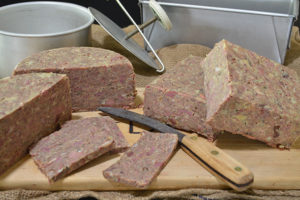 Good old fashioned recipes are hard to beat. To successfully make a good smoky pork brawn you need devotion and time to make it a success. Our lessons began with Dwane’s grandmother on a winters morning huddled in the kitchen beside the Crown wood fired stove. She gave us an education on cooking with a wood fire.
Good old fashioned recipes are hard to beat. To successfully make a good smoky pork brawn you need devotion and time to make it a success. Our lessons began with Dwane’s grandmother on a winters morning huddled in the kitchen beside the Crown wood fired stove. She gave us an education on cooking with a wood fire.
The recipe for the Smoky venison and pork brawn requires the meat to simmer half the day or until the meat falls from the bone. We always allocated a full day to the process. A couple of wheel barrows full of wood was chopped to keep the fire going. The spare time in between wasn’t wasted besides telling a few yarns we would have the ingredients organised to make a batch of tomato relish. Nothing beats fresh pork brawn and tomato relish sandwich at the end of a brawn making session.
Those days have passed and lessons we have both treasured. We are proud that we can still carry on the tradition and hope that we can deliver the recipe to another generation or to somebody who can enjoy this as much as we do. This recipe originated from the old days when nothing was wasted and all the food that a farmer produced was utilized in some form or another.
Dwane and I have since made a few changes to the recipe with flavours we both desire. In addition we began to smoke the corned venision shin before adding it to the recipe.
View recipe here Smoky Venison and Pork Brawn
MEAT SMOKING PROCESS
Climate control
 The winter months are the best to attempt this process. There is a reduced risk of the meat spoiling. These crispy cold nights with no wind are perfect conditions for a consistent burn rate. The sawdust will smoulder most of the night and you don’t have the blowflies hanging around.
The winter months are the best to attempt this process. There is a reduced risk of the meat spoiling. These crispy cold nights with no wind are perfect conditions for a consistent burn rate. The sawdust will smoulder most of the night and you don’t have the blowflies hanging around.
The smoking chamber
We use an old 44 gallon drum and use recycled Webber kettle racks as shelving and a piece of corrugated iron a top for our smoking drum. The drum is far from elaborate but it works a treat. The lid doesn’t need to seal, it is there to trap some of the smoke in the chamber. The sawdust needs to be able to breathe to allow the sawdust to keep smouldering. Place a sheet of corrugated iron under the drum and tip a 10 litre bucket of sawdust onto the iron. Any gas fired smoking ovens will do the job also.
Smoking dust
We like to use hoop pine as my smoking dust for a subtle flavour. Hardwood is also good if you like a stronger smoke flavour.
Spread the sawdust out so it takes up the inside diameter of the drum. In the centre of the sawdust pile make a small divot. Place fine wood chips over the hole to make a small fire and light. When the fire goes out the sawdust will begin to smoulder.
Place 4 house bricks around the outside of the sawdust pile to sit the smoking drum on. Put the meat on the racks inside the drum with the lid on and position the drum over the sawdust. Ventilation is the key by allowing the smoke to draw.
BRAWN MAKING PROCESS
The traditional recipe is a pigs head cut in half. The eyes, ears, tongue and snout to be removed by your butcher unless you know how to do this yourself and a corned beef shin. This is where you have the option of using a shin that has been smoked. The jelly in the shin meat and a percentage of fat from the pigs head is what sets the brawn. Use only 10 percent of the fat and skin from the pigs head unless you prefer eating fatty meats.
To make a larger quantity we have added a piece of corned venison silverside as well as the corned shin from the butcher that we smoked overnight.
Cooking the meat
The following morning is when the process takes place. As we do not have a Crown stove anymore, a gas burner is perfect method for boiling the meat. Add all the meat to a large boiler and cover with water and cook together. The brine and smoke flavours transfer throughout the meat partially curing the pork during the cooking stage. This gives the meat a pinkish colour and one that is more desirable when it comes to presentation.
You will need a brawn press or containers you can use to press the meat into. A cake tin with a plate that fits into the tin with a heavy item on top will be sufficient or I also use a bread tin If I have made a larger batch, a piece of thin plywood cut to size be sufficent and use a house brick for a weight to help press the meat in the tin.
Follow these guidelines and combine with the formula and I can assure you if you like smallgoods this won’t be the first and last time you use this good old fashioned smoky pork and venison brawn recipe.
Serve on a freshly baked slice of bread with tomato relish or pickles.




